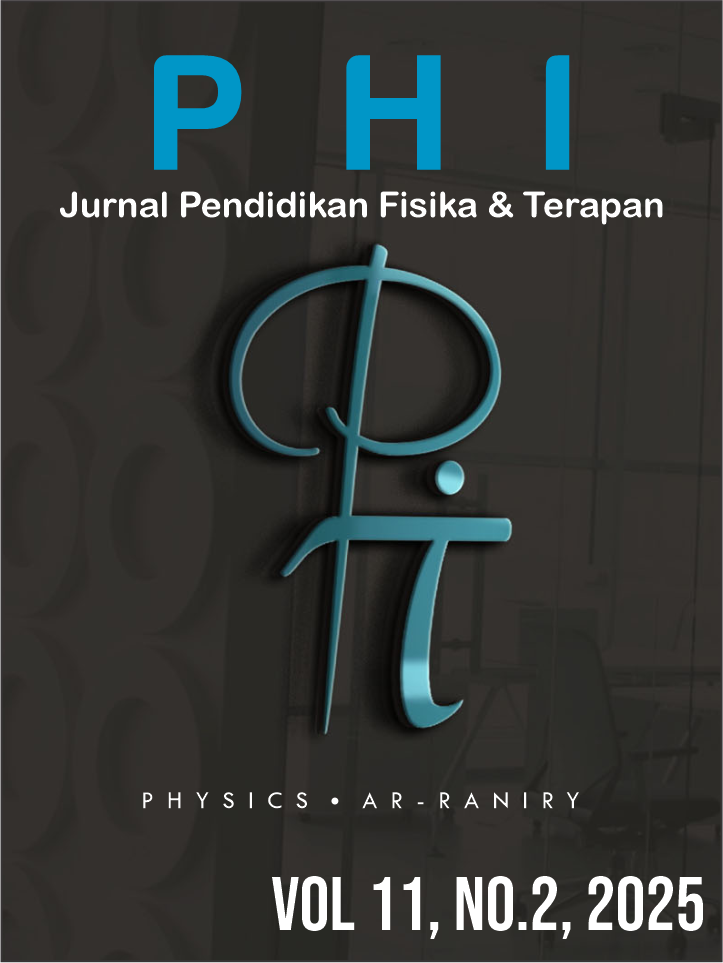Simulation of Radiation Dose Distribution in Radiodiagnostic Facilities Using FLUKA Monte Carlo Code
DOI:
https://doi.org/10.22373/hj0xjk86Keywords:
Monte Carlo, FLUKA, Radiation, Dose, Validation, RadiodiagnosticAbstract
This study investigates the application of Monte Carlo simulations using the FLUKA code to evaluate the radiation dose distribution in the radiodiagnostic facility of the Fatmawati Medical Check Up Clinic. The objective is to compare the simulation results with experimental measurements and assess the accuracy of the simulation method. The research was carried out in the Physics Modelling Laboratory, Integrated Laboratory of State Islamic University (UIN) Sunan Gunung Djati Bandung, using an HP Proliant ML350P server computer equipped with Intel® Xeon® CPU E5-2620 v2 @ 2.10GHz × 12 cores. The simulation involved modeling the radiation chamber and photon emission plane, configured to emit 9×10⁹ photons at an energy level of 60 keV. Scattered radiation doses were measured at several locations, corresponding to experimental measurement points for validation. The results showed a strong correlation and high level of accuracy between the simulation and experimental data, with a relative error of less than 1%.References
Akhadi Mukhlis. (2000). Dasar - dasar Proteksi Radiasi. PT Rhineka Cipta.
Anjomrouz, M., Bakht, M. K., & Sadeghi, M. (2016). Feasibility study of FLUKA Monte Carlo simulation for a beta-emitting brachytherapy source: Dosimetric parameters of 142Pr glass seed. Journal of Radioanalytical and Nuclear Chemistry, 309(3), 947–953. https://doi.org/10.1007/s10967-016-4744-2
Arizal, Muh. Z., Santoso, B., Panular, D. B., & Anita, F. (2017). Analisis Radiasi Hambur di Luar Ruangan Klinik Radiologi Medical Check Up (MCU). Jurnal Ilmiah Giga, 20(2), 44. https://doi.org/10.47313/jig.v20i2.556
BAPETEN. 2013. Peraturan Kepala Bapeten No. 4 Tahun 2013 Tentang Keselamatan Radiasi dalam Pemanfaatan Tenaga Nuklir. Jakarta : Badan Pengawas Tenaga Nuklir
Battistoni, G., Boehlen, T., Cerutti, F., Chin, P. W., Esposito, L. S., Fassò, A., Ferrari, A., Lechner, A., Empl, A., Mairani, A., Mereghetti, A., Ortega, P. G., Ranft, J., Roesler, S., Sala, P. R., Vlachoudis, V., & Smirnov, G. (2015). Overview of the FLUKA code. Annals of Nuclear Energy, 82, 10–18. https://doi.org/10.1016/j.anucene.2014.11.007
Bazo, J., Rojas, J. M., Best, S., Bruna, R., Endress, E., Mendoza, P., Poma, V., & Gago, A. M. (2018). Testing FLUKA on neutron activation of Si and Ge at nuclear research reactor using gamma spectroscopy. Nuclear Instruments and Methods in Physics Research Section A: Accelerators, Spectrometers, Detectors and Associated Equipment, 885, 1–6. https://doi.org/10.1016/j.nima.2017.12.042
F. Baluti, “Monte Carlo Simulations of Chemical Vapour Deposition Diamond Detectors,” Thesis/Dissertations, University of Canterbury., 2009.
Ferrari, A., et al. (2003). The FLUKA code: present applications and future developments. arXiv preprint arXiv:physics/0306162. https://arxiv.org/abs/physics/0306162
Ferrari, A., Sala, P. R., Fassò, A., & Ranft, J. (2005). FLUKA : A multi-particle transport code.
FLUKA. (2019). 5th Fluka Advanced Course and Workshop . Advance Scoring.
Fuadi, N., Jusli, N., & HArmini. (2022). PEMANTAUAN DOSIS PERORANGAN MENGGUNAKAN THERMOLUMINESCENCE DOSIMETER (TLD) DI WILAYAH PAPUA DAN PAPUA BARAT TAHUN 2020-2021. Jurnal Sains Fisika, 2(1), 63–74.
Haneefa, K. A., Cyriac, T. S., Musthafa, M. M., Raman, R. G., Hridya, V. T., Siddhartha, A., & Shakir, K. K. (2014). FLUKA Monte Carlo for basic dosimetric studies of dual energy medical linear accelerator. Journal of Radiotherapy, 2014, 343979. https://doi.org/10.1155/2014/343979
Infantino, A., Cicoria, G., Lucconi, G., Pancaldi, D., Vichi, S., Zagni, F., Mostacci, D., & Marengo, M. (2017). Radiation Protection Studies for Medical Particle Accelerators using Fluka Monte Carlo Code. Radiation Protection Dosimetry, 173(1–3), 185–191. https://doi.org/10.1093/rpd/ncw302
Lee, C., Lee, S., Lee, S.-J., Song, H., Kim, D.-H., Cho, S., Jo, K., Han, Y., Chung, Y. H., & Kim, J. S. (2017). Monte Carlo simulation of secondary neutron dose for scanning proton therapy using FLUKA. PLOS ONE, 12(10), e0186544. https://doi.org/10.1371/journal.pone.0186544
M Z Abdul Aziz, S Yani, F Haryanto, N. Kamarullah Ya Ali, S.M. Tajudin, H. Iwase, M. Musarudin (2020). Monte Carlo simulation of X-ray room shielding in diagnostic radiology using PHITS code, Journal of Radiation Research and Applied Sciences, Volume 13, Issue 1,Pages 704-713. https://doi.org/10.1080/16878507.2020.1828020
Nemati, M. J., Habibi, M., & Amrollahi, R. (2013). Analysis of concrete labyrinth shielding and radiation dose for APF plasma focus neutron source by FLUKA Monte Carlo code. Journal of Radioanalytical and Nuclear Chemistry, 295(1), 221–226. https://doi.org/10.1007/s10967-012-2196-x
Nugraheni, F., Anisah, F., & Susetyo, G. A. (2022). Analisis Efek Radiasi Sinar-X pada Tubuh Manusia. Prosiding SNFA (Seminar Nasional Fisika Dan Aplikasinya), 19.
Ochoa-Parra, P., Schweins, L., Abbani, N., Ghesquière-Diérickx, L., Gehrke, T., Jakubek, J., Marek, L., Granja, C., Dinkel, F., Echner, G., Winter, M., Mairani, A., Harrabi, S., Jäkel, O., Debus, J., Martišíková, M., & Kelleter, L. (2024). Experimental validation of a FLUKA Monte Carlo simulation for carbon-ion radiotherapy monitoring via secondary ion tracking. Medical Physics, 51(12), 9217–9229. https://doi.org/10.1002/mp.17408
Pignol, J.-P., Cuendet, P., Brassart, N., Fares, G., Colomb, F., Diop, C. M., Sabattier, R., Hachem, A., & Prevot, G. (1998). Combined use of FLUKA and MCNP-4A for the Monte Carlo simulation of the dosimetry of 10B neutron capture enhancement of fast neutron irradiations. Medical Physics, 25(6), 885–891. https://doi.org/10.1118/1.598264
Pratiwi, A. D., Indriyani, & Yunawati, I. (2021). Penerapan Proteksi Radiasi Di Instalasi Radiologi Rumah Sakit. HIGEIA Journal Of Public Health Research And Development, 5(3).
Priatam, P. P. T. D., Zambak, M. F., Suwarno, & Harahap, P. (2021). Analisa Radiasi Sinar Matahari Terhadap Panel Surya 50 WP. Rekayasa Elektrikal Dan Energi : Jurnal Teknik Elektro, 4(1).
Ramdani, R., Amalina, S. S., & Aliah, H. (2021). Studi Awal Simulasi Head Linear Accelerator (LINAC) Menggunakan Metode Monte Carlo-FLUKA. Prosiding Seminar Nasional Fisika 7.0, 209–213.
Rizani, A., Budi, W., & Anam, C. (2012). Simulasi Monte Carlo Untuk Menentukan Dosis Sinar-X 6 MV Pada Ketakhomogenan Medium Jaringan Tubuh. 15, 49–56.
Schoonwater, J. (2019). Designing a 30 MeV electron beam dump with low photoneutron production using FLUKA. Eindhoven University of Technology.
Tusnski, D. S., Szpigel, S., Giménez de Castro, C. G., MacKinnon, A. L., & Simões, P. J. A. (2019). Self-consistent modeling of gamma-ray spectra from solar flares with the Monte Carlo simulation package FLUKA. Solar Physics, 294(103). https://doi.org/10.1007/s11207-019-1499-2
Downloads
Published
Issue
Section
License
Copyright (c) 2025 Wildan Muhammad Zyan

This work is licensed under a Creative Commons Attribution-NonCommercial 4.0 International License.
Authors who publish with Jurnal Phi agree to the following terms:
- Authors retain copyright and grant the journal right of first publication with the work simultaneously licensed under a Creative Commons Attribution License (CC BY 4.0) that allows others to share the work with an acknowledgment of the work's authorship and initial publication in this journal.
- Authors are able to enter into separate, additional contractual arrangements for the non-exclusive distribution of the journal's published version of the work (e.g., post it to an institutional repository or publish it in a book), with an acknowledgment of its initial publication in this journal.
- Authors are permitted and encouraged to post their work online (e.g., in institutional repositories or on their website) prior to and during the submission process, as it can lead to productive exchanges, as well as earlier and greater citation of published work (See The Effect of Open Access).

















